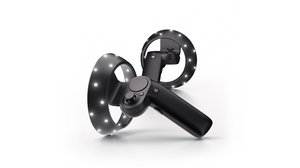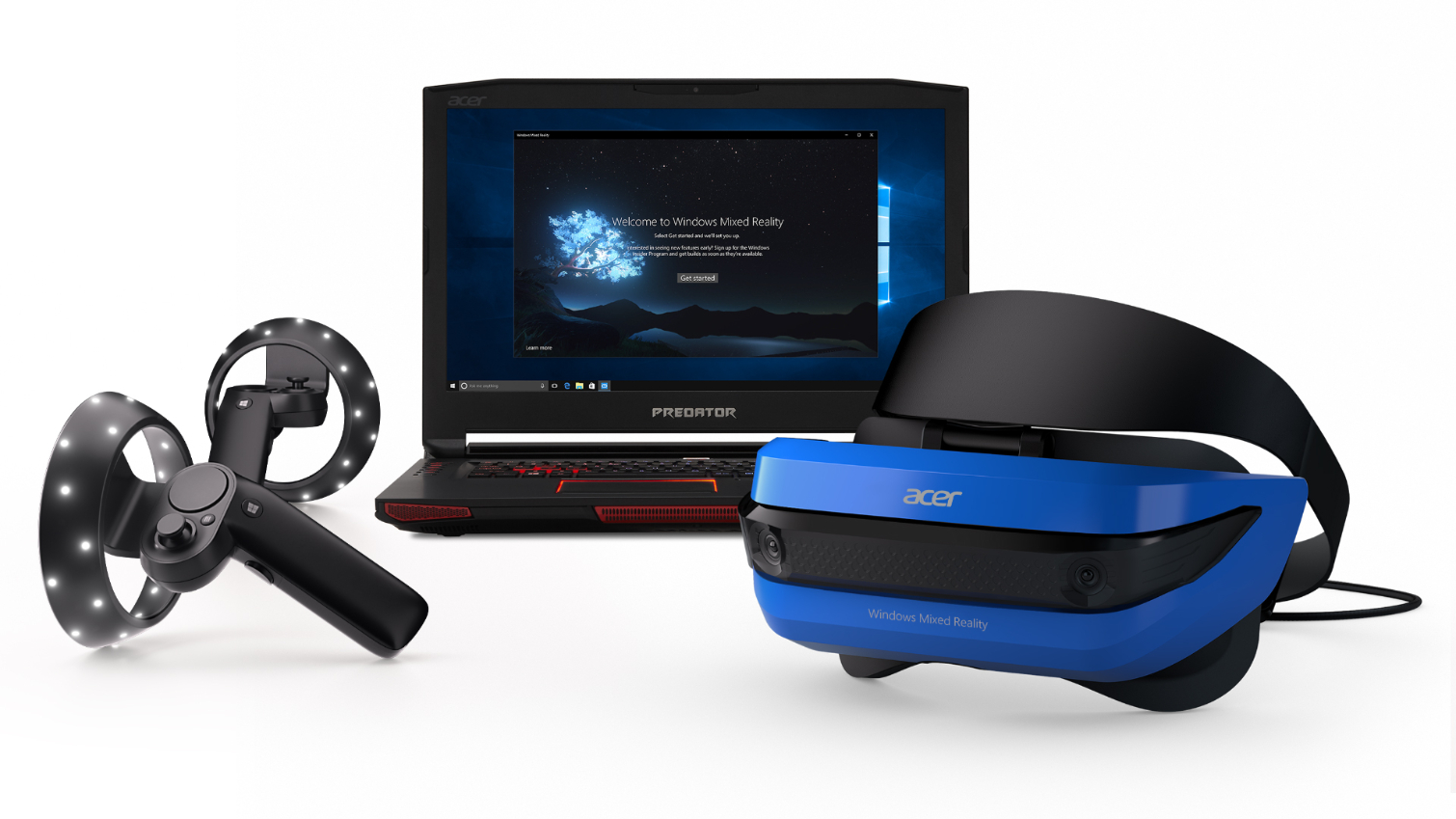Microsoft’s Mixed Reality Controllers, Hands On
After making it all the way to San Francisco, I thought, perhaps, I was being tricked. Or maybe just had the wrong street? No, this was the right address. But instead of a shiny, glass-infused, modern-looking building where I would find Microsoft, I stood there blinking at this:
Unsure whether I was about to step into a 1980s action movie-style mafia drug deal or the meeting I was supposed to be attending, I pushed open the door and found, to my great relief, the latter.
This was my chance to finally give Microsoft’s new Windows Mixed Reality controllers a try.
Familiar?
When Microsoft first announced its Windows Mixed Reality controllers at Build earlier this year, we noted that they were reminiscent of the superb Oculus Touch controllers. When we gave them a go in person, we felt the same.
We weren’t allowed to take any photos or video, but you can see some of the controllers’ similarities when they’re side by side:


Both feature a ring around the grip, a trigger, a joystick, a button mounted on the shaft, touchpad, and a couple other buttons. We don’t want to overstate the similarities, but note that these Microsoft devices have more in common, design-wise, with the Touch controllers than with the HTC Vive’s wands.
6DoF Tracking, Wasted Just A Little
The biggest difference, though, is that the Microsoft controllers offer inside-out 6DoF tracking, so you don’t need to deal with any external sensors. The sensor array is baked onto the front/sides of the HMD (in the case of this demo, it was the Acer HMD) and can “see” the controllers in your hands.
Get Tom's Hardware's best news and in-depth reviews, straight to your inbox.
For the most part, we found that using the Microsoft controllers was intuitive. For example, when you go to grab something, you squeeze the shaft button. The joysticks are pronounced, and they’re the first thing your fingers find when you grab the controllers. The touchpad is right next to those, and they’re large and responsive. Between the joystick and touchpad is a menu button.
Anecdotally (and subjectively), we found the tracking on the controllers to be quite solid. We never noticed any lag, even in first person shooters, and because the sensors are mounted on the HMD, we never turned our bodies such that we lost tracking, which is one of the cloying issues facing users of the Oculus Rift. We suppose technically you could move your arms far enough behind you that the sensors lose track of them, but that would probably require you to de-socket your arms, which is quite hard to do and is also a terrible idea.
You can, however, reach behind your back to pull a virtual weapon out of your virtual quiver, for example.
In fact, the inside-out tracking makes it so you can walk anywhere in the world, thereby allowing you to roam freely in VR while moving about the real world in a 1:1 distance--if it wasn’t for that consarned tether. Yep: You’re still tethered to a PC with these Windows Mixed Reality HMDs. And it’s still just as annoying to constantly have to fling it out of your way all the time like a too-long hairdo.
Alas.
One aspect of the design that surprised us a bit is that the controllers connect to the HMD via Bluetooth. Bluetooth is...what it is...but it does have a certain amount of built-in lag. Microsoft finds that lag acceptable even as it keeps finding ways to optimize its drivers for better performance. Again, we certainly didn’t notice the lag, even when we were capping zombies in the head in Arizona Sunshine.
However, what did drive us nuts was the placement of the Windows buttons. Yes, these controllers have a Windows button, which exits whatever experience you’re in and kicks you back to the home area. We accidentally hit it so many times. We’ve been assured that one becomes accustomed to the button placement, which ostensibly means that one would stop hitting it by accident every minute or so, but we’re doubtful.
New Drivers Coming Hard And Fast
We were surprised to find some new features and tweaks even since Build. For example, there’s a polished chaperone system, better navigation, improved battery life on the controllers, and more.
The chaperone system is just like any you’ve seen on other higher-end HMDs. We noticed that the play area was defined by a polygonal shape, not a box. It appears that you can fine tune the play area; for example, you can define furniture and the like when you draw the playspace.
Microsoft hasn’t gotten around to setting max and min playspace limits, but for context, the HoloLens can do about 50 x 50 feet, and these HMDs will be able to do something in the same ballpark. Of course, for now, you’re effectively limited by the cable tether. So there’s that.
We’ll get into the aspects of movement and the battery life in a bit, but it’s important to note that many of these performance details are in flux because of how insanely fast new drivers are getting pushed out the door. Updates are coming daily--sometimes multiple times per day--to tweak and optimize and introduce new features.
Microsoft, it seems, is in a sprint. These controllers need to be done, with fully baked and optimized features by the holidays, and there hasn’t been much lead time for the folks banging out all this code. For context, we’ve discovered that the reason we couldn’t find the controllers anywhere at Build (and we tried every trick and hustle in the book) was because the controllers pretty much didn’t exist yet. That was the middle of May, which means they have to get a product from prototype to store shelves in about six months. (Fortunately, from what we observed, the controllers are working quite well at this stage.)
Battery
Judging by the pile of AA batteries (or was it AAAs?) on the floor in a corner of the room, we presume that the controllers run on regular batteries. No one would commit to a battery life estimate; partially that was due to the fact that this particular crew of Microsofters hadn’t exactly been keeping precise track, and partially because the steady stream of updates keeps improving it.
The target, in any case, is eight hours on a set of batteries. (Quietly, the goal is more like 10 hours). But for now, with new drivers landing all the time, you can expect multiple hours on a charge, at least.
Movement
Back at Build, we spent a good bit of time navigating a mixed reality environment with an Xbox controller, so we learned something about the locomotion controls that. It’s the same with the controllers, oddly; you can snap your view 45 degrees by tapping the joystick in this or that direction.
Otherwise it mostly uses a teleportation mechanic whereby you aim the controller at a certain area, you see a an arc-shaped path, and then you click to move to that spot. It’s a fast way to get where you need to. Depending on the experience, you can also use the joysticks to move smoothly all around, like you normally would in a first person game. (Beware, though: We saw this at play in Minecraft VR, and it was a bit of a nausea-inducing way of getting around.)
In the home area, there are numerous apps “hung” on the wall like so many windows (oh, that makes sense), and it’s a little clunky to navigate over to any given one and try to view it. To solve that problem, Microsoft built in a way to square yourself in front of any given app: Once you’re mostly in front of a window, you can aim directly at it and use the teleport mechanic to snap to. Then you’ll find yourself with an app centered perfectly in front of you, like you were looking at a computer monitor.
You can also effectively mimic the click and drag mechanic by using both hands and both triggers; simply grab two edges of an object to be scaled and expand or shrink whatever is (proverbially) in your hands.
A Party For Laptops Only
Although Microsoft could certainly have set up a desktop or two for the demos it was showing, it ran everything on laptops. As if to make a point. Well, point taken: You can definitely run high-end VR content on laptops with Windows Mixed Reality.
We played Space Pirate Trainer, Arizona Sunshine, and Superhot with the Acer HMD and motion controllers, with no noticeable performance issues, graphics degradation, or input lag, on a Razer Blade Pro. We don’t know the exact specifications, but the laptop should be running an Intel Core i7-6700HQ with an Nvidia GTX 1080. That’s some beefy hardware, but we were told that you could get acceptable performance even with a GTX 1060 GPU in there.
The Razer Blade Pro’s fans did go nuts after a short time in VR, but we were shocked to learn that the laptop hadn’t been cleaned up to run the demos. We think it may have been the demonstrator’s daily machine, actually, with miscellaneous applications running in the background, just like anyone’s PC under normal conditions.
We also played Minecraft VR on an Ultrabook--a newish HP Spectre X 360, in fact. It had an i7 chip, but it was still an Ultrabook chip for crying out loud, and it was running integrated graphics. Note that there’s a severe limitation when it comes to integrated graphics, though: IGP will get you only 60 FPS.
And All The Rest
Although it hasn’t been confirmed yet, we believe that you’ll be able to buy these motion controllers separately soon, even though for now they’re available only in bundles with HMDs. They’ll be available this holiday season.
Seth Colaner previously served as News Director at Tom's Hardware. He covered technology news, focusing on keyboards, virtual reality, and wearables.
-
pegnose The controllers' tracking is outside-in. They are tracked by cameras external to themselves - sitting in the headset.Reply -
scolaner Reply20112996 said:The controllers' tracking is outside-in. They are tracked by cameras external to themselves - sitting in the headset.
..that's what the article says...so...? -
bit_user ReplyUnsure whether I was about to step into a 1980s action movie-style mafia drug deal or the meeting I was supposed to be attending, I pushed open the door and found, to my great relief, the latter.
Yeah, what the heck? They should've had a small logo or warned you ahead of time. Did they say anything about it? -
bit_user Reply
I think @pegnose was referring to this sentence:20114147 said:20112996 said:The controllers' tracking is outside-in. They are tracked by cameras external to themselves - sitting in the headset.
..that's what the article says...so...?
The biggest difference, though, is that the Microsoft controllers offer inside-out 6DoF tracking, so you don’t need to deal with any external sensors.
I guess you mean to say the HMD is inside-out. That the HMD also provides good outside-in tracking of the controllers seems somehow impressive.


